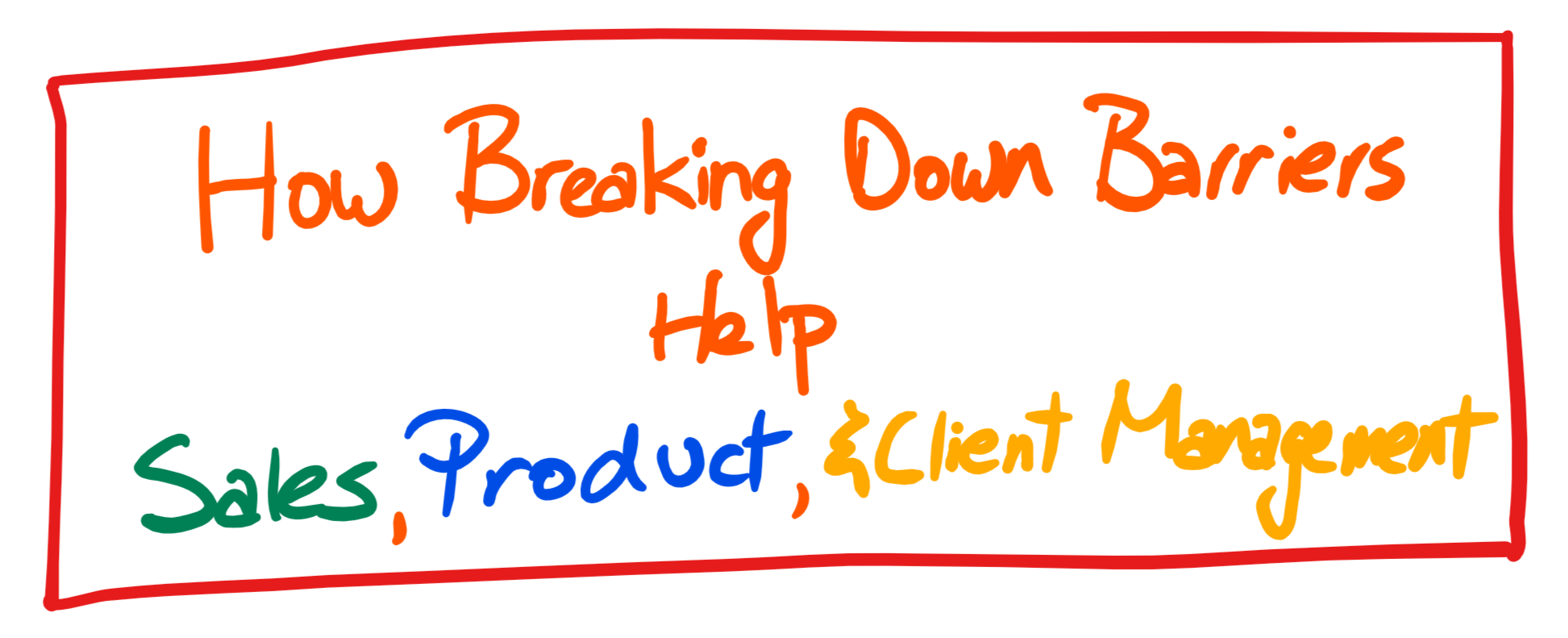This is Part II of the "Breaking Down Departmental Barriers" series. The articles in the series are:
I. 4 Reasons Why We Shouldn't Work in a Departmental Vacuum
II. Eliminating the Departmental Mindset: 4 Ways it Helps Sales, Product and Operations Teams (You are here)
III. 4 Tested Ways for Amazing Collaboration with Sales and Product
After getting smacked by my mentor, I knew we needed to start working outside of our departmental vacuum. The benefits of reaching out and participating are clear: a diversity of voices allows us to test and build better solutions for our clients, and PS gets an opportunity to have a say on what enters our pipeline.
But how does PS getting more involved with our colleagues benefit adjacent departments like Sales, Product, and Operations?
It seems patently unfair if a collaborative exercise only benefits one party. Before we started down the path to breaking down barriers and working directly with different teams, I wanted to be absolutely certain that we are participating for the right reasons. It was crystal clear to me that we have to provide genuine value for our colleagues, otherwise we are just introducing make work projects that increase friction, not decrease it.
How do we participate with our colleagues to genuinely provide value? I looked at the pain of each of our adjacent teams and came up with the primary benefit for each of them: sales, product, and client management:
1. We Help Product Teams Pattern Recognize Problems and Anticipate Market Forces - PS teams serve not just one client, but every client in the organization that needs our technical solutioning. The variety of clients we see gives us an opportunity to analyze patterns in individual problems we solve for them. Identifying and relaying those patterns back to our product teams serve two major purposes: We can help product identify product improvements that will benefit a majority of our clients (and thus giving our efforts the best bang for buck). We also identify market trends based on what our clients are planning on their roadmaps so we can create anticipatory solutions for problems that won't manifest for weeks, months, or years to come. By aggregating and contextualizing client and market patters, we offer critical intelligence to product teams so they can plan ahead of the compeition.
2. We Help Sales Teams Understand and Articulate Technical Pain - I'm a firm believer that PS team should aim to build trusted advisor relationships with our clients. When clients trust our advice, they become less inhibited in sharing their problems and feedback. Our job is to take what we learn from our clients, strip out what is technically superfluous, and clearly articulate actionable context to our sales team. Effective context allows the sales teams to accurately attack the pain points for potential clients that may be experiencing the exact same problems as our existing ones. A lot of sales teams are unafraid of technical details and jargon, but distilling the most important parts of what we learn gives them a concentrated medicine to help cure client pain and win in the next sales cycle.
3. We Help Client Management Teams Identify Chronic and Non-Urgent Issues that Lead To Major Customer Satisfaction Problems - Big roadblocks get a lot of attention by all internal teams, but small ones are rarely given the same fanfare. The trouble is, if small problems and issues become chronic, clients may feel we have abandoned the possibility of serving them with a solid product. Over time, that sentiment leads to a toxic perception that we just simply don't care. We usually have visibility to these problems because as trusted advisors, our clients are more than happy to let us know when they're not happy -- we just have to pay attention because problems like this end up being prefaced with "it's a small issue, don't worry about it". The thing is, we SHOULD worry about it, and flagging these chronic problems to the client management teams will ensure they're not blindsided the next time they meet with the client. What's more important is that client management can muster cross-team effort to help solve these seemingly minor problems before they fester into a major customer satisfaction issue.
We're so focused on being trusted advisors and building great solutions for our clients that we often forget that we are part of a greater team that serves them. Being in the position we are in to be exposed to so many client issues and market forces, it is our reponsibility to work with our colleagues so everyone can benefit from our analysis and experience.
Next week, I share a few concrete tactics that I have used in the past to break down barreirs and help all teams participate together to learn, plan, react, and execute.
